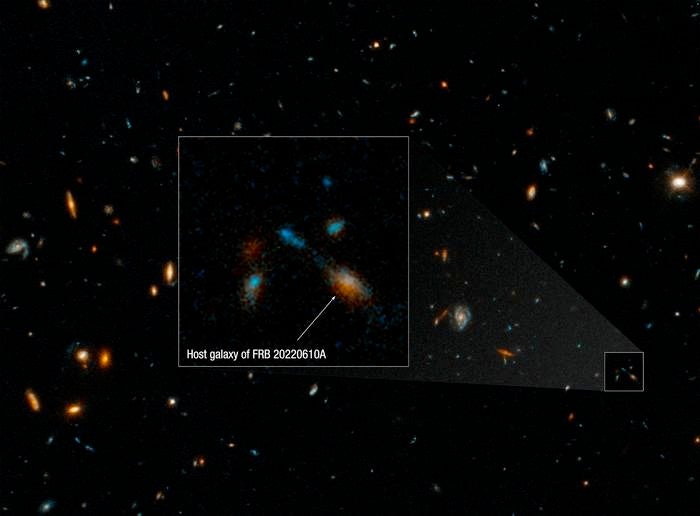
Since they first were discovered in 2007, fast radio bursts (FRBs) have vexed astronomers.
Just as the name implies, they’re fast (on the order of millisecond) flashes of energy in the radio part of the spectrum. While some repeat and others disappear quickly into the cosmic night, astronomers still can’t quite pin down what causes an FRB, aside from extreme environments like those in a black hole or neutron star system.
But a recently described FRB from 9 billion light-years away could give astronomers an assist in tracing their origins. Not only is it the farthest spotted to date, but it’s one of the most unusual. That’s because when astronomers tried to pinpoint where it came from, they encountered a group of seven dwarf galaxies slowing coming together into one large galaxy.
Revenge of the ‘blob’
In fact, when astronomers first described the “object” via the Very Large Telescope (VLT), they weren’t quite sure what it was, and they just called it a “blob.”
“We had never seen something that was so blobby looking — we weren’t sure if this was just a really sort of amorphous bizarre galaxy or if there were maybe multiple galaxies, interacting or merging and we just couldn’t tell due to the resolution from the ground,” Northwestern University graduate student Alexa Gordon says.
Gordon, who is studying FRBs, led the study, which was recently presented at the 243rd meeting of the American Astronomical Society. (A preprint of the paper is available here.) Once the VLT images felt more like a sci-fi creature that creeps and leaps than a distinct object, the astronomers applied for time on the Hubble Space Telescope, which helped identify the strange galactic cluster.
It consists of one large dwarf galaxy surrounded by six smaller dwarf galaxies, all within about the same space as the Milky Way. At least two show signs of undergoing a present merger with the largest galaxy, but Gordon says all seven are likely to merge into one galaxy. (Large galaxies are almost always formed from smaller galaxies that have merged together.)
But those galaxies also show signs of active star formation. Stars often form from clouds of gas expelled by other stars that have gone supernova. That actually could provide a clue as to what happened in this distant galaxy cluster.
An uncommon fast radio burst
“One of the big open questions in FRBs is what causes them, what their progenitor is,” Gordon says. “And one of the leading theories is something called a magnetar, which is a highly magnetic neutron star.” A neutron star is the ultra-compact husk of a large star that exploded into a supernova.
“If we think FRBs come from magnetars, they should be connected to recent star formation,” Gordon says. And galactic mergers can trigger star formation, giving that idea a lot of credence as well.
But this wasn’t a common FRB. This one was four times more energetic than usual, which has proved a little more perplexing.
“So, in that sense, it has thrown a wrench into those theories, but it’s still possible based on what we think causes FRBs, that you can still match this with progenitor theories, we just had to do some revision of theories,” Gordon says.
Alongside this little mystery is another, which is that the signal of the FRB showed qualities as if it had come from further than it had. This is measured in dispersion, which is basically how material scatters a radio signal between its origin and us here on Earth. And this can’t be accounted for with just the seven galaxies present, meaning something bigger dispersed it on its way toward Earth, despite a relatively clear line of sight. This is something Gordon and colleagues will look into for subsequent studies.
In the meantime, add FRB 20220610A to the growing list of fast radio bursts — and give it a few awards, too.









